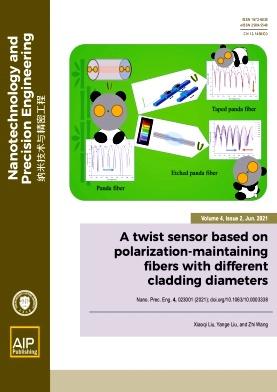Simulation and fabrication of in vitro microfluidic microelectrode array chip for patterned culture and electrophysiological detection of neurons
IF 3.5
3区 工程技术
Q2 MATERIALS SCIENCE, MULTIDISCIPLINARY
Nami Jishu yu Jingmi Gongcheng/Nanotechnology and Precision Engineering
Pub Date : 2024-01-02
DOI:10.1063/10.0023849
引用次数: 0
Abstract
To enable the detection and modulation of modularized neural networks in vitro, this study proposes a microfluidic microelectrode array chip for the cultivation, compartmentalization, and control of neural cells. The chip was designed based on the specific structure of neurons and the requirements for detection and modulation. Finite-element analysis of the chip’s flow field was conducted using the COMSOL Multiphysics software, and the simulation results show that the liquid within the chip can flow smoothly, ensuring stable flow fields that facilitate the uniform growth of neurons within the microfluidic channels. By employing MEMS technology in combination with nanomaterial modification techniques, the microfluidic microelectrode array chip was fabricated successfully. Primary hippocampal neurons were cultured on the chip, forming a well-defined neural network. Spontaneous electrical activity of the detected neurons was recorded, exhibiting a 23.7% increase in amplitude compared to neuronal discharges detected on an open-field microelectrode array. This study provides a platform for the precise detection and modulation of patterned neuronal growth in vitro, potentially serving as a novel tool in neuroscience research.用于神经元模式化培养和电生理检测的体外微流控微电极阵列芯片的模拟与制作
为实现体外模块化神经网络的检测和调控,本研究提出了一种用于培养、分隔和控制神经细胞的微流控微电极阵列芯片。该芯片是根据神经元的特殊结构以及检测和调制的要求设计的。利用 COMSOL Multiphysics 软件对芯片的流场进行了有限元分析,模拟结果表明芯片内的液体流动顺畅,确保了稳定的流场,有利于神经元在微流控通道内均匀生长。通过采用 MEMS 技术和纳米材料改性技术,成功制作了微流控微电极阵列芯片。原代海马神经元被培养在芯片上,形成了一个定义明确的神经网络。与在开场微电极阵列上检测到的神经元放电相比,记录到的神经元自发电活动的振幅增加了 23.7%。这项研究为体外精确检测和调控模式化神经元生长提供了一个平台,有可能成为神经科学研究的一种新工具。
本文章由计算机程序翻译,如有差异,请以英文原文为准。
求助全文
约1分钟内获得全文
求助全文
来源期刊

Nami Jishu yu Jingmi Gongcheng/Nanotechnology and Precision Engineering
Engineering-Industrial and Manufacturing Engineering
CiteScore
6.50
自引率
0.00%
发文量
1379
审稿时长
14 weeks
 求助内容:
求助内容: 应助结果提醒方式:
应助结果提醒方式:


